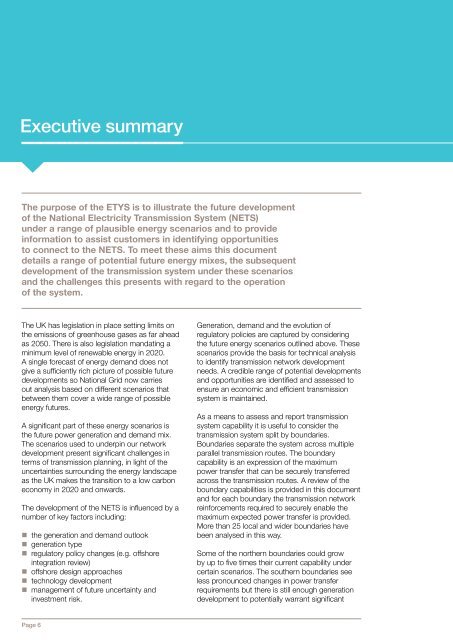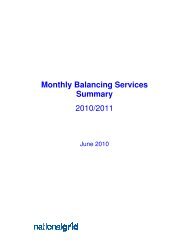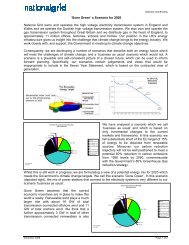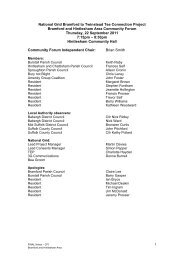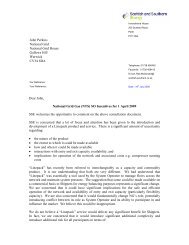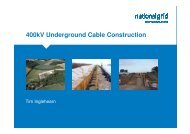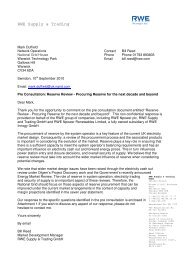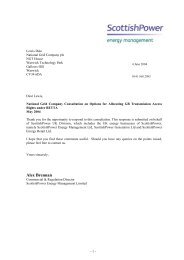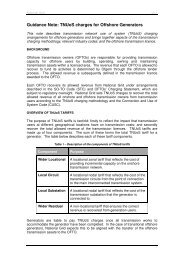Electricity Ten Year Statement - National Grid
Electricity Ten Year Statement - National Grid
Electricity Ten Year Statement - National Grid
You also want an ePaper? Increase the reach of your titles
YUMPU automatically turns print PDFs into web optimized ePapers that Google loves.
Executive summary<br />
The purpose of the ETYS is to illustrate the future development<br />
of the <strong>National</strong> <strong>Electricity</strong> Transmission System (NETS)<br />
under a range of plausible energy scenarios and to provide<br />
information to assist customers in identifying opportunities<br />
to connect to the NETS. To meet these aims this document<br />
details a range of potential future energy mixes, the subsequent<br />
development of the transmission system under these scenarios<br />
and the challenges this presents with regard to the operation<br />
of the system.<br />
The UK has legislation in place setting limits on<br />
the emissions of greenhouse gases as far ahead<br />
as 2050. There is also legislation mandating a<br />
minimum level of renewable energy in 2020.<br />
A single forecast of energy demand does not<br />
give a sufficiently rich picture of possible future<br />
developments so <strong>National</strong> <strong>Grid</strong> now carries<br />
out analysis based on different scenarios that<br />
between them cover a wide range of possible<br />
energy futures.<br />
A significant part of these energy scenarios is<br />
the future power generation and demand mix.<br />
The scenarios used to underpin our network<br />
development present significant challenges in<br />
terms of transmission planning, in light of the<br />
uncertainties surrounding the energy landscape<br />
as the UK makes the transition to a low carbon<br />
economy in 2020 and onwards.<br />
The development of the NETS is influenced by a<br />
number of key factors including:<br />
the generation and demand outlook<br />
generation type<br />
regulatory policy changes (e.g. offshore<br />
integration review)<br />
offshore design approaches<br />
technology development<br />
management of future uncertainty and<br />
investment risk.<br />
Page 6<br />
Generation, demand and the evolution of<br />
regulatory policies are captured by considering<br />
the future energy scenarios outlined above. These<br />
scenarios provide the basis for technical analysis<br />
to identify transmission network development<br />
needs. A credible range of potential developments<br />
and opportunities are identified and assessed to<br />
ensure an economic and efficient transmission<br />
system is maintained.<br />
As a means to assess and report transmission<br />
system capability it is useful to consider the<br />
transmission system split by boundaries.<br />
Boundaries separate the system across multiple<br />
parallel transmission routes. The boundary<br />
capability is an expression of the maximum<br />
power transfer that can be securely transferred<br />
across the transmission routes. A review of the<br />
boundary capabilities is provided in this document<br />
and for each boundary the transmission network<br />
reinforcements required to securely enable the<br />
maximum expected power transfer is provided.<br />
More than 25 local and wider boundaries have<br />
been analysed in this way.<br />
Some of the northern boundaries could grow<br />
by up to five times their current capability under<br />
certain scenarios. The southern boundaries see<br />
less pronounced changes in power transfer<br />
requirements but there is still enough generation<br />
development to potentially warrant significant


